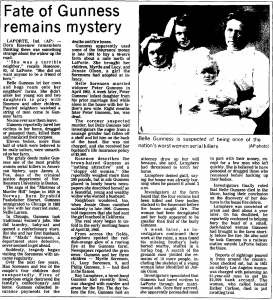We have a tendency to envision our ancestors as upstanding members of society. In some cases, they were. In others, they were anything but. I first stumbled across Belle Gunness while researching the Midwestern ancestry of a client, and I’ve been disgusted and oddly intrigued by her ever since.
Belle Poulsdatter was born circa 1860 in Norway. She emigrated to America and settled in Chicago, Illinois, where she married Mads Anton Sorenson in 1884. The couple had several children, two of whom died under unusual circumstances.[1] Then, Mads Sorenson died suddenly on 30 July 1900. Belle (Poulsdatter) Sorenson collected her husband’s life insurance and opened a candy store in Chicago.[2] The candy store and the Sorenson house both burned down shortly thereafter. Belle collected the fire insurance money, moved to La Porte, Indiana, and married Peter Gunness, who died shortly after their marriage.[3]
Belle (Poulsdatter) (Sorenson) Gunness would be a pitiable figure if she hadn’t been a mass murderer. Soon after the death of her second husband, Belle began placing and responding to personal ads in the local newspapers. Many men seemed to come to the Gunness farm. Few were seen leaving the establishment.[4]
On 27 April 1908, Ray Lamphere, a farm laborer and Belle Gunness’ lover, set fire to the Gunness house. Four bodies were recovered after the fire, and it was reported that Belle Gunness and her children had been killed.[5] The prosecutors who charged Lamphere with arson and murder claimed that he was jealous of Belle Gunness’ relationships with the men who answered her personal ads.[6]
After the fire, several shallow mass graves were discovered on the Gunness farm. Some remains were identified as belonging to men who had corresponded with Belle via the personal ads she placed in local papers: Andrew Helgelein and Ole Budsberg. Another set of remains was identified as belonging to Jennie Olsen, a girl adopted by Belle Gunness who had allegedly gone to Los Angeles, California, for school.[7] Some of the remains were never identified, but it was determined that at least ten people had been buried in the graves.[8]
During Ray Lamphere’s trial, farmhands testified that Belle Gunness had repeatedly had them dig large holes in her back yard, and that she had filled them herself.[9] Later, Lamphere allegedly confessed to his attorney that he had helped Gunness bury the bodies after she had killed the men, and that she had killed over forty men in all.[10] He also claimed that he had set fire to the Gunness farm to help Belle escape, that she hadn’t died in the fire, and that the two were supposed to be reunited after he was released from prison. Ray Lamphere contracted tuberculosis and died in prison in 1909.[11]
Some historians argue that Ray Lamphere lied, and that Belle Gunness died in 1908. Others argue that the adult body found after the fire couldn’t have been Belle Gunness, as it was decapitated and weighed considerably less than Belle Gunness’ estimated weight.[12] To this day, no one knows for sure what became of Belle Gunness, although sightings of her were reported until 1935.[13]
Belle Gunness, an unlikely femme fatale, managed to disrupt the lives of dozens of people. At least one of her victims, Ole Budsberg, had children, and it is likely that others did as well. Because most of the men she killed were never identified, it is entirely possible that someone, somewhere, is researching their family history and encountering a genealogical roadblock that may never be solved.
Notes
[1] “Garbage Creeps Across Murder Farm Where 42 Died,” Odessa American, 18 May 1958.
[2] “Ghastly Puzzle May Be Solved,” Burlington Evening Gazette, 9 November 1908.
[3] “Garbage Creeps Across Murder Farm Where 42 Died,” Odessa American, 18 May 1958.
[4] “Lonely? Got Money? Be Careful!” Cedar Rapids Gazette, 17 April 1949.
[5] “Ghastly Puzzle May Be Solved,” Burlington Evening Gazette, 9 November 1908.
[6] “Lonely? Got Money? Be Careful!” Cedar Rapids Gazette, 17 April 1949.
[7] “Ghastly Puzzle May Be Solved,” Burlington Evening Gazette, 9 November 1908.
[8] “Garbage Creeps Across Murder Farm Where 42 Died,” Odessa American, 18 May 1958.
[9] “Ghastly Puzzle May Be Solved,” Burlington Evening Gazette, 9 November 1908.
[10] “Garbage Creeps Across Murder Farm Where 42 Died,” Odessa American, 18 May 1958.
[11] “Is Silent on Lamphere Death,” Mount Pleasant Daily News, 31 December 1909.
[12] “Garbage Creeps Across Murder Farm Where 42 Died,” Odessa American, 18 May 1958.
[13] Ibid.
Share this:

About Julie Wilmot
Julie, a native of Errol, New Hampshire, holds a Bachelor of Arts degree in Anthropology with a concentration in Native American Studies from the University of Maine, Orono, and a Master of Arts degree in History and Culture from Union Institute and University. She has worked at the Northeast Archives of Folklore and Oral History in Orono, Maine, and was a presenter at the New England Historical Association Spring 2014 Conference in Springfield, Massachusetts. Her research interests include French-Canadian migration to Northern New England, and international cases.View all posts by Julie Wilmot →
